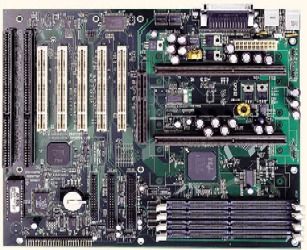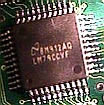Asus P2B-DS
 Abit BP6
Abit BP6
EPoX KP6-BS
Shuttle HOT-649A
Tyan S1832DL
Tech Talk
Dual Celeron
UDMA66 vs SCSI
Intel CPU Fan Hack
LVS SCSI
CPU Core Temp.
 |
|||||||||||||||||||||||||||||||
Tyan Tiger100 (a.k.a. S1832DL)Low cost Dual Pentium II/III motherboardby Derek Kwan
 Tyan's Tiger 100 (a.k.a. S1832DL) it is a
designed in USA motheboard. It has soultions as a low cost dual slot 1 motherboard for home users. This board
is very similiar to EPoX's KP6-BS, it has 5 PCI slot and 2 ISA slot (one share), dual UDMA/33 channel. It also
come with a "Proprietary Server Managment Connector" for future use, it seems to has a SMBus connector, but
it is better to use ABIT's BP6 (low cost) or Shuttle's HOT-649A (require SCSI) for server. Tyan's Tiger 100 (a.k.a. S1832DL) it is a
designed in USA motheboard. It has soultions as a low cost dual slot 1 motherboard for home users. This board
is very similiar to EPoX's KP6-BS, it has 5 PCI slot and 2 ISA slot (one share), dual UDMA/33 channel. It also
come with a "Proprietary Server Managment Connector" for future use, it seems to has a SMBus connector, but
it is better to use ABIT's BP6 (low cost) or Shuttle's HOT-649A (require SCSI) for server.
This motherboard is the only motherboard we tested with a LED on board to show the board status. And this is a nead feature espically when you are testing a board and you can tell if the board is in sleep mode or it is actually power off. Setting up this motherboard is fairly simple except in the manual, it only shows a support up to 333MHz for 66MHz FSB and 450MHz for 100MHz FSB. That means we have to go to tyan web site to get the proper multiplier jumper (JP11, 12, 13 & 14) settings for our 366MHz Celeron processor (which is 5.5x FSB ratio). From the Tyan web site, it now shows support up to 7x for 466MHz Celeron processors. Once we have setup the multiplier jumper, the FSB is actually set via the CMOS. With a choice of 66.8Mhz, 68.5MHz, 75MHz, 83.3Mhz, 100MHz, 103Mhz and 112Mhz. It would be nice if it can go as high as 150MHz. By default it will detect Celeron processor runs at 66MHz FSB and Pentium II/III processors runs at 100MHz FSB. You can change the FSB in CMOS but one thing to remember is to ENABLE the overclock warning. This caught us the for the first time, if you leave the warning message DISABLE, even if you have set the FSB higher than it suppose to use, upon POST, it will display the CPU is running at faster frequency. But when you use utilities like CPUID or CPUCLK, it will shows the CPU runs at it default speed. So when you want to overclock you CPU, make sure you leave the warning message enable (and I know it can be pretty annoying. BTW, what's the point of having the option to disable the warning message anyways?). Also another thing need to mention, this motherboard is having problems to display correct CPU speed when it is overclocked. For example, a 366MHz Celeron runs at 75MHz (75MHz x 5.5 = 412.5MHz), during POST it will report it is a Celeron 433A. If running at 83MHz (83MHz x 5.5 = 456.5MHz) POST will report as Celeron 466A. But atleast it will detect 366MHz if not overclocked. (grin) IMHO, overclocking is not an excuse for these simple errors.
We have also noticed there is a empty pad next to LM75 and it is possible spare for MAX1617A/LM84 type hardware monitoring IC to measure CPU core temperature. But sine this is a loaner machine we do not have time for futher investigation. (Note: The LM75 use on Tiger 100 is a 5V version. The one use on EPoX KP6-BS is a 3V version) Also with the latest BIOS (1.16a) there is (still) a bug which mixed up the fan sensors in CMOS. In order to map the fan sensors correctly in CMOS, you have to connect the fans as following:-
However one thing that we do like about this board is that it gives lots of options to fine tune low level hardware setting. For example options to enable or disable PERR#, SERR#, WSC# setting. In conclusion, this is a entry level dual slot 1 motherboard and still have room to improve.
Overall Score:
|

